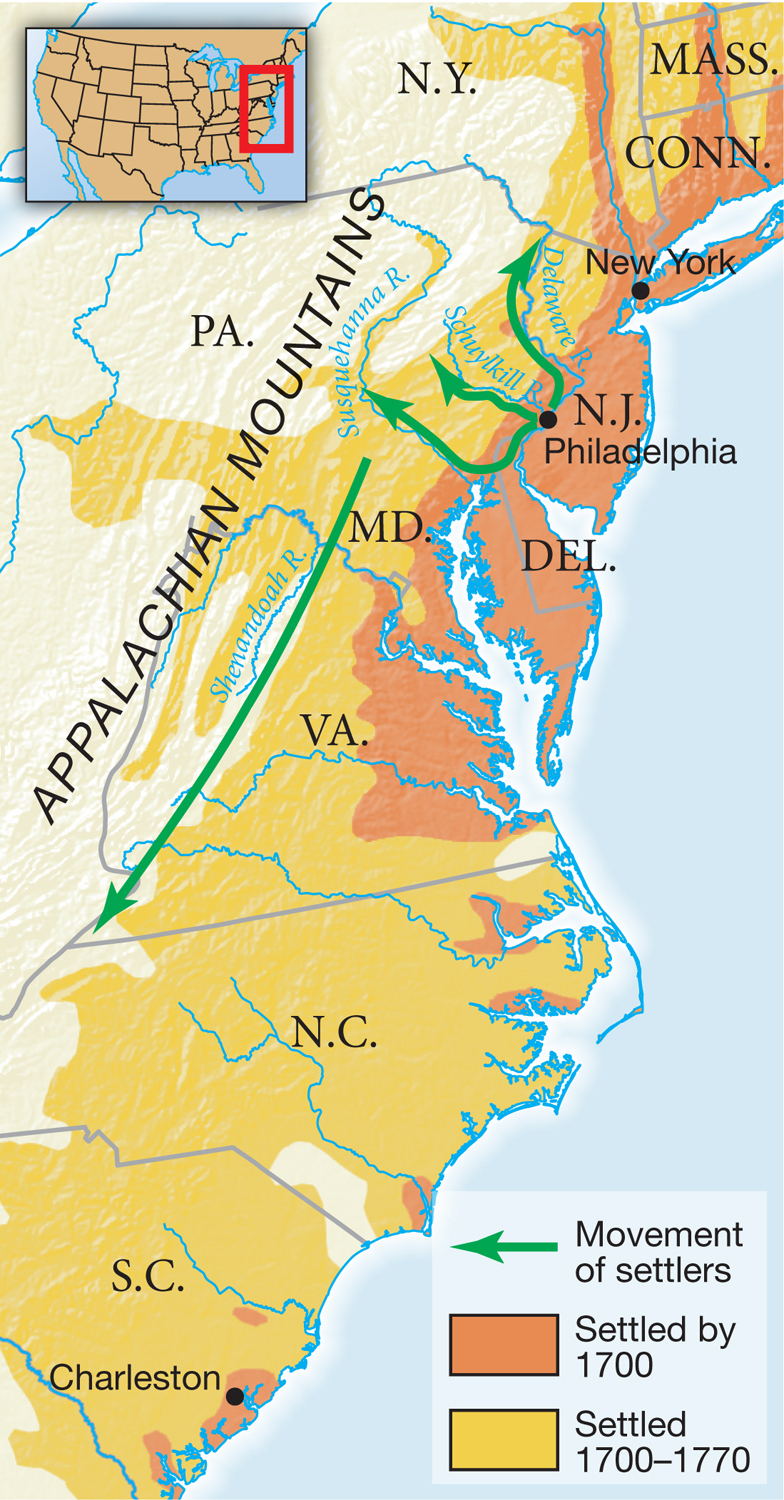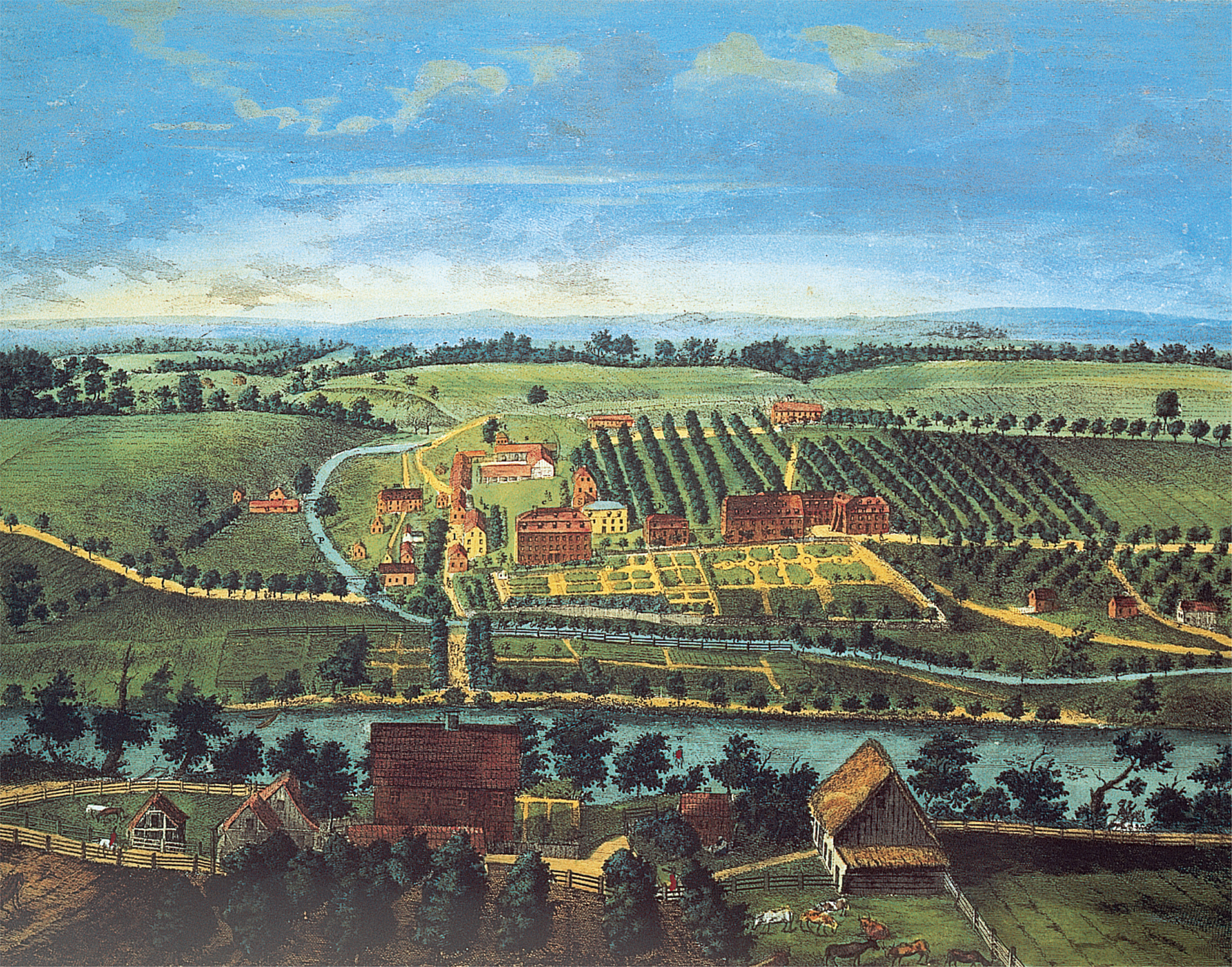The American Promise:
Printed Page 114
The American Promise Value
Edition: Printed Page 108
Chapter Chronology
“God Gives All Things to Industry”: Urban and Rural Labor
An indentured servant in 1743 wrote that Pennsylvania was “the best poor Man’s Country in the World.” Although the servant reported that “the Condition of bought Servants is very hard” and masters often failed to live up to their promise to provide decent food and clothing, opportunity abounded in the middle colonies because there was more work to be done than workers to do it.
Most servants toiled in Philadelphia, New York City, or one of the smaller towns or villages. (See “Visualizing History.”) Artisans, small manufacturers, and shopkeepers prized the labor of male servants. Female servants made valuable additions to households, where nearly all of them cleaned, washed, cooked, or minded children. From the masters’ viewpoint, servants were a bargain. A master could purchase five or six years of a servant’s labor for approximately the wages a common laborer would earn in four months.
Since a slave cost at least three times as much as a servant, only affluent colonists could afford the long-term investment in slave labor. Most farmers in the middle colonies used family labor, not slaves. Wheat, the most widely grown crop, did not require more labor than farmers could typically muster from relatives, neighbors, and a hired hand or two. Consequently, although people of African ancestry (almost all slaves) increased to more than thirty thousand in the middle colonies by 1770, they accounted for only about 7 percent of the total population and much less outside the cities.
Most slaves came to the middle colonies and New England after a stopover in the West Indies, as the Robin Johns did. Very few came directly from Africa. Slaves—unlike servants—could not charge masters with violating the terms of their contracts. Colonial laws punished slaves much more severely than servants for the same offense. A master’s commands, not a written contract, set the terms of a slave’s bondage. Small numbers of slaves managed to obtain their freedom, but no African Americans escaped whites’ firm convictions about black inferiority.
Whites’ racism and blacks’ lowly social status made African Americans scapegoats for European Americans’ suspicions and anxieties. In 1741, when arson and several unexplained thefts plagued New York City, officials suspected a murderous slave conspiracy and executed thirty-one slaves. On the basis of little evidence other than the slaves’ “insolence” (refusal to conform fully to whites’ expectations of servile behavior), city authorities burned thirteen slaves at the stake and hanged eighteen others. Although slaves were certifiably impoverished, they were not among the poor for whom the middle colonies were reputed to be the best country in the world.
Immigrants swarmed to the middle colonies because of the availability of land. The Penn family (see “New Jersey and Pennsylvania” in chapter 4) encouraged immigration to bring in potential buyers for their enormous tracts of land in Pennsylvania. From the beginning, Pennsylvania followed a policy of negotiating with Indian tribes to purchase additional land. This policy reduced the violent frontier clashes more common elsewhere in the colonies. Few colonists drifted beyond the northern boundaries of Pennsylvania. Owners of the huge estates in New York’s Hudson valley preferred to rent rather than sell their land, and therefore they attracted fewer immigrants. The Iroquois Indians dominated the lucrative fur trade of the St. Lawrence valley and eastern Great Lakes, and they vigorously defended their territory from colonial encroachment, causing most settlers to prefer the comparatively safe environs of Pennsylvania.

Patterns of Settlement, 1700–1770
Since the cheapest land always lay at the margin of settlement, would-be farmers tended to migrate to promising areas just beyond already improved farms. By midcentury, settlement had reached the eastern slopes of the Appalachian Mountains, and newcomers spilled south down the fertile valley of the Shenandoah River into western Virginia and the Carolinas. Thousands of settlers migrated from the middle colonies through this back door to the South. Abraham Lincoln’s great-grandfather, John Lincoln—whose own grandfather, Mordecai, had migrated from England to Puritan Massachusetts in the 1630s—moved his family in the 1760s from Pennsylvania down the Shenandoah Valley into Virginia, where the future president’s grandfather, also named Abraham, raised his family, including the future president’s father, Thomas Lincoln.
Farmers like the Lincolns made the middle colonies the breadbasket of North America. They planted a wide variety of crops to feed their families, but they grew wheat in abundance. Flour milling was the number one industry and flour the number one export, constituting nearly three-fourths of all exports from the middle colonies. Farmers profited from the grain market in the Atlantic world. By 1770 a bushel of wheat was worth twice as much (adjusted for inflation) as it had been in 1720. The steady rise of grain prices after 1720 helped make the standard of living in rural Pennsylvania higher than in any other agricultural region of the eighteenth-century world. The comparatively widespread prosperity of all the middle colonies permitted residents to indulge in a half-century shopping spree for British imports. The middle colonies’ per capita consumption of imported goods from Britain more than doubled between 1720 and 1770, far outstripping the per capita consumption of British goods in New England and the southern colonies.

VISUAL ACTIVITY Bethlehem, Pennsylvania This view of Bethlehem, Pennsylvania, in 1757 dramatizes the profound transformation of the natural landscape humans wrought in the eighteenth century. In less than twenty years, precisely laid-out orchards and fields replaced forests and glades. By carefully penning their livestock (lower center right) and fencing their fields (lower left), farmers safeguarded their livelihoods from the risks and disorders of untamed nature. Individual farmsteads (lower center) and brick town buildings (upper center) integrated the bounty of the land with community life. Few eighteenth-century communities were as orderly as Bethlehem, but many effected a comparable transformation of the environment. The New York Public Library/Art Resource, NY. READING THE IMAGE: What does this painting indicate about the colonists’ priorities? CONNECTIONS: Why might Pennsylvanians have been so concerned about maintaining order?
Philadelphia stood at the crossroads of trade in wheat exports and British imports. Merchants occupied the top stratum of Philadelphia society. In a city where only 2 percent of the residents owned enough property to qualify to vote, merchants built grand homes and dominated local government. Many of Philadelphia’s wealthiest merchants were Quakers. Quaker traits of industry, thrift, honesty, and sobriety encouraged the accumulation of wealth. A colonist complained that a Quaker “prays for his neighbors on First Days [Sabbaths] and then preys on him the other six.”
The lower ranks of merchants included aspiring tradesmen such as Benjamin Franklin. In 1728, Franklin opened a small shop, run mostly by his wife Deborah, that sold a little of everything: cheese, codfish, coffee, goose feathers, soap, and occasionally a slave. In 1733, Franklin began to publish Poor Richard’s Almanack, which preached the likelihood of long-term rewards for tireless labor and quickly became Franklin’s most profitable product. The popularity of Poor Richard’s Almanack suggests that many Pennsylvanians thought less about the pearly gates of heaven than about their pocketbooks. Poor Richard’s advice that “God gives all Things to Industry” might be considered the motto for the middle colonies. The promise of a worldly payoff made work a secular faith. Poor Richard advised, “Work as if you were to live 100 years, Pray as if you were to die Tomorrow.”
Although Quakers remained influential in Pennsylvania, Franklin spoke for most colonists with his aphorisms of work, discipline, and thrift that celebrated the spark of ambition and the promise of worldly gain.
REVIEW Why did immigrants flood into Pennsylvania during the eighteenth century?

